Jan
The trucking industry is entering a pivotal period, marked by shifts in freight demand, economic growth, and technological advancements. Here’s an in-depth look at what the market trends indicate and how businesses can prepare for the opportunities ahead.
Transition to a New Business Cycle
The trucking industry is leaving behind the pandemic-driven volatility and entering a steadier business cycle. According to DAT Freight & Analytics, truckload pricing is expected to rise gradually, reaching pre-pandemic growth rates by the second quarter of 2025. With fewer new carriers entering the market and capacity tightening, rate increases will likely become the norm.
For businesses, this means planning for higher operational costs while exploring opportunities to improve efficiency and maintain competitiveness.
Economic Growth and Freight Demand
The U.S. economy is projected to grow at a moderated pace of 2.0% year-over-year in 2025, as noted by ACT Research. While high borrowing costs and tempered consumer spending are expected to slow growth, freight demand should remain steady. Industries will need to adapt to this constrained environment by focusing on cost control and strategic planning.
Equipment Production Outlook
The production of Class 8 trucks, medium-duty vehicles, and trailers is forecasted to decline in 2025 due to high inventories and cautious fleet expansions. However, regulatory changes related to emissions standards may drive fleet upgrades. Specific segments, such as refrigerated trailers, might see some resilience in demand. For details, visit ACT Research.
Stability In Trucking is Increasing
According to the Bureau of Labor Statistics, since the peak in July 2022, the trucking industry has lost 42,000 truck driving positions. The worst year of shedding came in 2023, with a staggering loss of 35,000 jobs. This last year, there has been a loss of 6,000 jobs, with only 500 happening since August of 2024. This decrease in job loss shows a promising trend towards a more stable market, which is a good sign that the industry could get back to a period of growth in the near future. While this two year down turn has been absolutely brutal, the downturn in shipping rates will increase as the overcapacity in drivers flattens out.
Strategic Recommendations for Growth
To thrive in the evolving market, consider these strategies:
- Flexible Procurement: Adopt dynamic approaches to procurement, especially on lower-volume lanes, which are prone to pricing volatility. (DAT Report)
- Cost Control: Prioritize cost controls and ensure reliable service to position your business favorably as the market tightens. (DAT Report)
- Technological Integration: Invest in automation and analytics tools to boost operational efficiency and adaptability. (DAT Blog)
Final Thoughts
The trucking industry is poised for significant changes, offering both challenges and opportunities. By staying informed and proactive, businesses can position themselves for growth and resilience. For further reading, check out these additional resources:
- Trucking Industry Shows Signs of Life After Long Downturn
- Truckers Are Projecting an Upturn in Freight Rates
Stay ahead of the curve by monitoring these trends and adapting your strategies to align with the market’s trajectory.

Jan
Winter weather has arrived and there is a lot to consider
As Winter Storm Cora intensifies across the southern United States, truck drivers are facing unique and serious challenges. According to The Weather Channel, this storm will impact a broad stretch of the country, bringing snow, ice, and hazardous conditions, especially to regions like Texas, Oklahoma, Arkansas, and parts of the Carolinas. While the storm’s impact is widespread, it’s crucial for truck drivers to understand how the weather conditions will affect their ability to operate safely.
In this blog post, we’ll break down the weather forecast and the associated challenges truck drivers will face, offering important safety tips for navigating the storm.
Weather Overview: Winter Storm Cora’s Path
The Weather Channel forecasts that Winter Storm Cora will bring significant snowfall and icy conditions to the southern U.S. from January 7-10. Areas of Texas, Arkansas, Louisiana, and the Carolinas are expected to receive accumulating snow, ice, and freezing rain. The storm is also likely to bring heavy winds and reduced visibility, making it even more dangerous for long-haul truck drivers and those driving in rural areas.
Southern states, not typically accustomed to snow and ice, may experience severe disruptions to road conditions. Road closures and delayed deliveries are a real possibility, particularly on overpasses and bridges where ice may form more quickly. As a result, truck drivers will need to exercise extra caution, plan alternate routes, and prepare for delays as they face these challenging winter conditions.
Challenges for Truck Drivers in Winter Storm Cora
Truck drivers will face numerous risks during Winter Storm Cora, many of which are exacerbated by snow, ice, and freezing rain. These winter weather challenges can cause major problems, especially for truck drivers navigating unfamiliar and unpredictable roads. Let’s take a closer look at the most pressing issues.
- Snow and Ice Accumulation
- Weather Impact: As the storm progresses, areas will experience accumulating snow and ice on the roads. The freezing rain forecasted for southern regions will create slick, dangerous conditions for drivers.
- Driving Challenge: Snow and ice drastically reduce traction, increasing the risk of accidents. Heavy trucks, which already have long stopping distances, will struggle to slow down or stop, increasing the likelihood of rear-end collisions and other accidents. Skidding and jackknifing are also real risks, especially when maneuvering on icy roads.
- Safety Tip: Drivers should reduce speed, increase following distances, and take extra care when changing lanes or turning. Always allow more time for braking.
- Reduced Visibility
- Weather Impact: Snowstorms and fog will significantly reduce visibility on the roads. In addition, shorter daylight hours mean more driving in the dark, which complicates conditions further.
- Driving Challenge: Poor visibility makes it harder for drivers to spot hazards such as obstacles, other vehicles, or signs. This can lead to sudden stops or dangerous maneuvers.
- Safety Tip: Always use your headlights when visibility is low and slow down to account for the limited sight distance. Make sure to check your mirrors regularly and keep your distance from other vehicles.
- Black Ice
- Weather Impact: The storm’s freezing rain will likely form black ice, which is often invisible to drivers and forms in shaded areas, bridges, and overpasses.
- Driving Challenge: Black ice is difficult to detect and poses a serious risk. When trucks hit black ice, they can slide uncontrollably, leading to accidents and rollovers.
- Safety Tip: Be cautious when driving on roads that are wet but below freezing temperatures. Avoid sudden movements, and steer gently if you encounter slippery spots.
- Tire Performance
- Weather Impact: Cold temperatures and icy roads can impact tire pressure, reducing traction and increasing the risk of blowouts or loss of control.
- Driving Challenge: Trucks with improperly inflated or worn-out tires have a much higher risk of losing traction on icy surfaces.
- Safety Tip: Check tire pressure before starting your route, and invest in winter tires that are designed for better grip in cold conditions. Make sure tires have adequate tread for snowy and icy roads.
- Brake Efficiency
- Weather Impact: Cold temperatures can make brake fluid less effective, resulting in reduced braking power.
- Driving Challenge: This reduces a truck’s ability to stop quickly, which is a dangerous issue when driving in snow or ice, where longer stopping distances are needed.
- Safety Tip: Perform regular brake system checks and maintenance, and be aware of spongy brake pedals or strange noises that may indicate problems. Consider using engine brakes to reduce the load on the primary braking system.
- Driver Fatigue
- Weather Impact: Stress and fatigue are inevitable when navigating dangerous conditions. The stress of winter driving, combined with the pressure of meeting deadlines, can cause fatigue to set in.
- Driving Challenge: Fatigue slows reaction times, impairs decision-making, and increases the risk of accidents, particularly in hazardous conditions.
- Safety Tip: Take regular breaks, get enough rest at night, and stay hydrated. Avoid heavy meals that can make you sluggish and reduce your ability to focus on the road.
- Poor Road Maintenance
- Weather Impact: Snow and ice can cause significant road hazards in areas where plowing and salting are insufficient, creating a particularly high risk in southern states that aren’t accustomed to winter weather.
- Driving Challenge: Potholes, cracks, and uneven surfaces covered in snow can damage trucks and lead to loss of control.
- Safety Tip: Report dangerous road conditions to local authorities when possible. If you’re unsure about the condition of your route, try to research road status updates before heading out.
Preparing for Winter Storm Cora
With these dangers in mind, here are a few steps truck drivers can take to prepare:
- Pre-trip inspections: Ensure tires, brakes, lights, and fluids are in good condition, and make sure your truck is equipped with an emergency kit.
- Defensive driving: Slow down, keep your distance from other vehicles, and be prepared for sudden stops. Avoid aggressive maneuvers, especially on icy surfaces.
- Emergency preparedness: Carry blankets, food, water, and a flashlight. Be prepared for breakdowns or getting stuck in snow.
Conclusion
Winter Storm Cora is a reminder of the importance of winter driving preparedness. The severe conditions it brings, including ice, snow, and reduced visibility, will challenge even the most experienced truck drivers. By staying alert, practicing defensive driving, and performing necessary pre-trip checks, truckers can reduce the risks associated with winter weather and keep themselves, and others, safe on the road.
Truck drivers should stay informed through reliable weather sources and plan their routes accordingly. Remember: safety always comes first—even if it means adjusting your delivery schedules or taking extra time to navigate hazardous conditions.
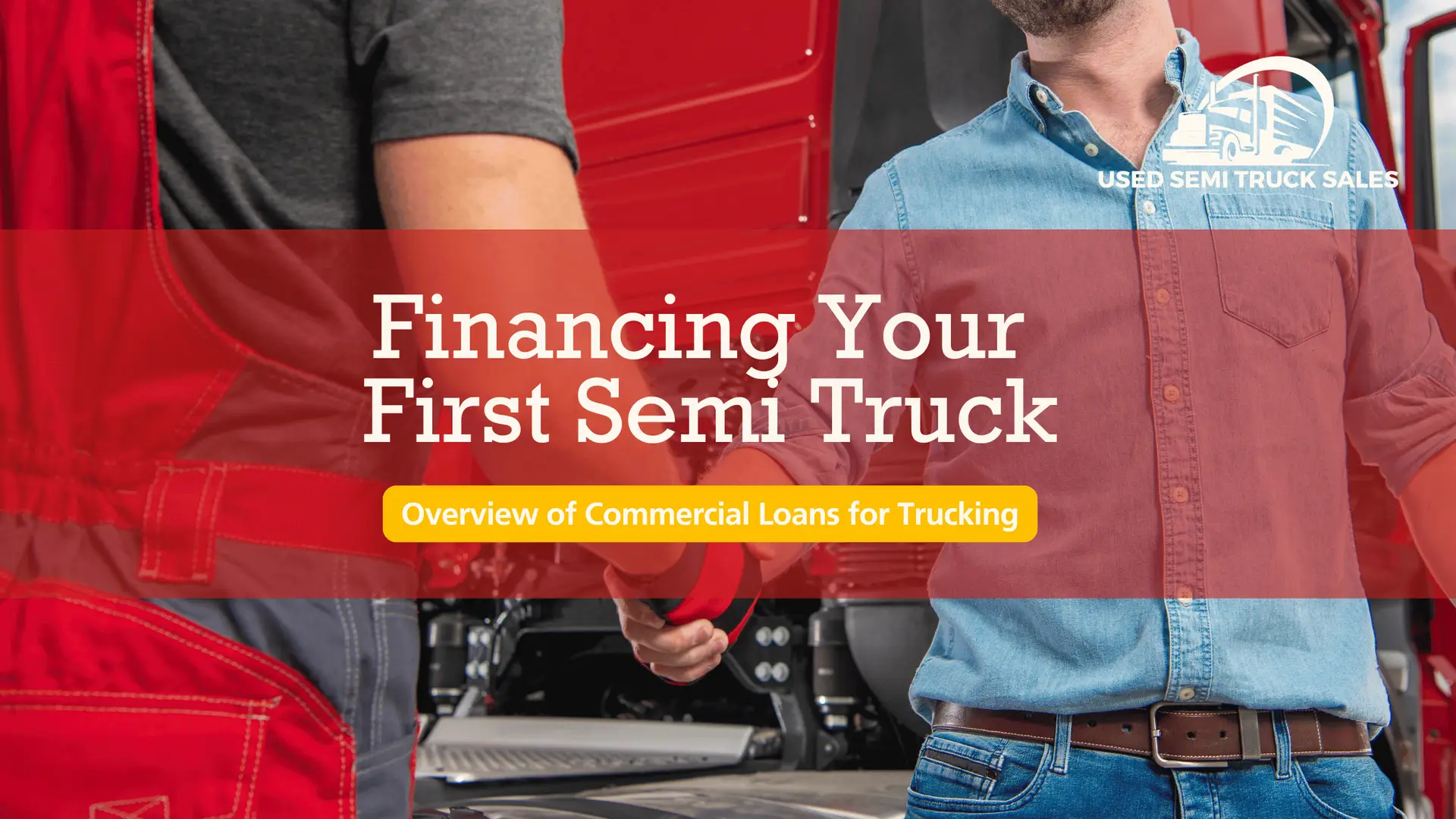
Oct
Deciding to become an owner-operator is a big step with a lot of rewarding possibilities, but it starts with securing the right truck and, often, the right financing. Here’s what you can expect when looking to finance your first used truck and the key factors to consider when making an informed decision.
1. Understanding Your Financial Options
When it comes to financing, used semi-truck buyers have a variety of options, each with unique benefits. Here are some common routes:
- Traditional Bank Loans: These are the most common among dealerships. Banks offer structured loans but typically require a solid credit score, a history of reliable income from trucking (usually 2 years of having a CDL), and sometimes collateral beyond the truck itself.
- Dealership Financing: There are a few dealerships that offer in-house financing, which may be more flexible in terms of credit requirements but can come with higher interest rates and a limited availability of trucks.
- Specialized Truck Financing Companies: Companies specializing in truck loans often offer tailored packages for owner-operators with options for flexible down payments, built-in maintenance accounts, and competitive rates, even for those with credit challenges.
- Equipment Financing Loans: These loans are typically used for construction equipment but have been coming into trucking for the last few years. These loans are not simple interest loans; these are where the payment is predetermined, and the agreement is set based on the acceptance of the trucking company. These are great tools for getting the equipment you need, as they typically don’t look at rate of expansion as much as they look at the contracts that you have in place to use the equipment.
- Lease to Own Contracts: There are several companies that offer a lease to own option. These are typically low-down payments with higher-than-average payments and a balloon payment at the end of term on used equipment coming out of either a dealership or fleet to get credit challenged customers behind the wheel.
2. Down Payments and Interest Rates
For first-time buyers, most lenders will require a down payment of around 20-30% of the truck’s value. However, special programs may be available that allow lower down payments. For example, some financing plans have low down payments, such as $6,000, which can make entry into truck ownership more accessible.
Interest rates on used truck financing can vary widely based on credit score, the truck’s age and mileage, and loan terms. Typical rates can range from 10% to 25%, with higher rates for those with low credit scores. Having a company like Used Semi Truck Sales shop your loan request to multiple financial institutions can be extremely beneficial, because when the companies are competing to get the business, they offer much more attractive terms to get the business.
3. Maintenance Accounts and Warranty Coverage
Some financing programs now offer added benefits, such as a maintenance account or comprehensive warranty. For instance, a built-in maintenance account can cover repairs and preventative upkeep—this not only saves out-of-pocket expenses but also keeps your truck on the road, reducing costly downtime.
Extended warranties are also available, offering peace of mind by covering significant repairs during the loan term. This can be a valuable addition, especially when starting with a used vehicle, which may have more wear and tear than a new model. When financing, you can include most extended warranties into the financing so there is a much more manageable monthly payment increase instead of paying all upfront. The average increase in monthly payment on a 3-year commercial loan is around $300.
4. No Credit? No Problem
For many first-time buyers, credit history can be a concern. Fortunately, some financing programs are designed specifically for those with limited or challenged credit backgrounds. Lenders specializing in truck financing may not require traditional credit checks, instead considering factors like income stability and employment history.
5. Creating a Realistic Budget
Besides the truck loan, owner-operators need to consider the full cost of ownership, including fuel, insurance, maintenance, and licensing. Building a budget before signing any financing agreement will ensure that monthly payments are affordable. It can also be beneficial to set aside a cushion for unexpected repairs or market fluctuations. We have seen huge success in companies that keep $12k-15k on hand per truck for maintenance and repairs. This is not something that you would need to have when purchasing your truck necessarily but setting aside a percentage of your income in a separate account for this is best practice.
6. Key Steps to Prepare for Financing
To secure the best financing terms, be prepared with the following:
- Proof of Income: Lenders need assurance that payments can be made consistently. Have pay stubs, bank statements, or tax returns ready.
- Down Payment: Being upfront with what you would like your down payment to be and what you would be able to come up with if required is important. Remember that showing a minimum 20% down is very attractive to a bank and typically where a dealership is going to want to be before sending it over to outside financing.
- Business Plan: Knowing where you are going to put the truck, what business name you’re going to put the truck under, the DOT and MC number of the authority you are going to drive under, business references that the bank can reach out to, and a solid history of what you have done is something that banks are asking for more and more in these difficult times in trucking. Having that prepared before asking for a loan is an easy win for you when they are looking at your application.
- Copy of your CDL: While having your CDL is not required by all financial institutions, there are a fair amount that want to have that and certainly all are going to give better terms if you have that. Making sure that your CDL is included with your application is something that will help get your application approved.
Financing your first used truck as an aspiring owner-operator is an achievable goal with the right information and preparation. Understanding your financing options, choosing a manageable loan, and creating a realistic budget are all essential steps to becoming a successful owner-operator. Whether you’re aiming to gain independence or control over your earnings, the right financing choice can make your journey smoother and your business more profitable.

Jul
The U.S. Department of Transportation (DOT) recently announced a substantial $1.8 billion investment in highway and infrastructure projects across the country. This funding, aimed at improving the nation’s transportation network, has significant implications for the trucking industry, which includes both individual drivers and fleet owners. However, with these improvements come certain challenges that need to be considered.
Key Investments in Trucking-Related Projects
Several projects funded by these grants are set to directly benefit the trucking industry. Here are some highlights:
- Alaska: $25 million will go towards upgrading 45 miles of the Alaska Highway in Fairbanks, addressing issues caused by thawing permafrost and climate change. This will ensure safer and more reliable routes for truck drivers.
- California: Another $25 million will be used to reconstruct a railroad bridge in Santa Ana, creating a new grade-separated underpass. This project aims to alleviate traffic congestion and improve safety, making travel smoother for truckers navigating busy intersections.
- Pennsylvania: In Sharpsburg, $24.9 million will fund the construction of a new bridge over the Conemaugh rail line and additional roadway improvements. This will enhance connectivity and reduce delays, benefiting both local drivers and interstate haulers.
- Arizona: A $23.5 million investment will reroute cross-border truck traffic away from downtown Douglas, implementing Complete Streets solutions to reduce roadway fatalities and serious injuries. This project includes resurfacing roads, improving pedestrian facilities, and enhancing overall traffic circulation.
- Alabama: A $3 million planning grant will study the removal of at-grade rail crossings and recommend new alignments to reduce railway blockages. This will minimize unnecessary idling and improve efficiency for truckers.
What This Means for Truck Drivers and Fleet Owners
Improved Road Conditions: With substantial investments in highway and bridge upgrades, truck drivers can expect smoother, safer journeys. Reduced congestion and better-maintained roads mean fewer delays and lower vehicle maintenance costs.
Enhanced Safety: Projects focusing on safety measures, such as the Complete Streets initiative in Arizona, aim to reduce accidents and improve the overall driving experience. Safer roads lead to fewer accidents and disruptions, benefiting both drivers and fleet operators.
Supply Chain Resilience: By improving key transportation links and reducing bottlenecks, these projects will enhance the efficiency of the supply chain. This is particularly important for fleet owners who rely on timely deliveries to maintain their operations.
Potential Drawbacks
Construction Disruptions: During the construction phase, there will likely be road closures, detours, and traffic congestion. These disruptions can cause significant delays for truck drivers, affecting delivery schedules and increasing fuel consumption due to longer routes. Construction zones often lead to bottlenecks and slower traffic flow, which can be frustrating for drivers and lead to longer transit times.
Increased Costs: Frequent travel through construction zones can lead to more wear and tear on vehicles. Potholes, rough surfaces, and debris can increase maintenance costs and the likelihood of needing repairs. Additionally, detours and longer travel routes during construction can result in higher fuel consumption, increasing operational costs for both individual drivers and fleet owners.
Economic Impact: Businesses near construction sites might experience decreased customer traffic due to road closures and reduced accessibility, potentially leading to financial losses. While construction projects create jobs in the long term, there can be temporary job disruptions for businesses and workers directly affected by the construction activities.
Long-Term Maintenance: Newly constructed infrastructure requires regular maintenance to remain functional. Without consistent funding and upkeep, the improvements may deteriorate over time, negating the initial benefits. Dependence on large federal grants for infrastructure can lead to challenges if future funding is not secured, resulting in incomplete projects or poorly maintained infrastructure.
Looking Ahead
Transportation Secretary Pete Buttigieg emphasized that these grants are part of a broader effort to modernize America’s infrastructure after years of underinvestment. These projects, supported by the Rebuilding American Infrastructure with Sustainability and Equity (RAISE) grants and additional funding from the Bipartisan Infrastructure Law, represent a significant step forward.
For truck drivers and fleet owners, these investments mean better roads, enhanced safety, and more reliable transportation networks. As these projects get underway, the trucking industry can look forward to a more efficient and resilient future.
Stay informed about these developments and how they might affect your routes and operations. Improved infrastructure is on the horizon, promising a brighter and more efficient future for everyone on the road.
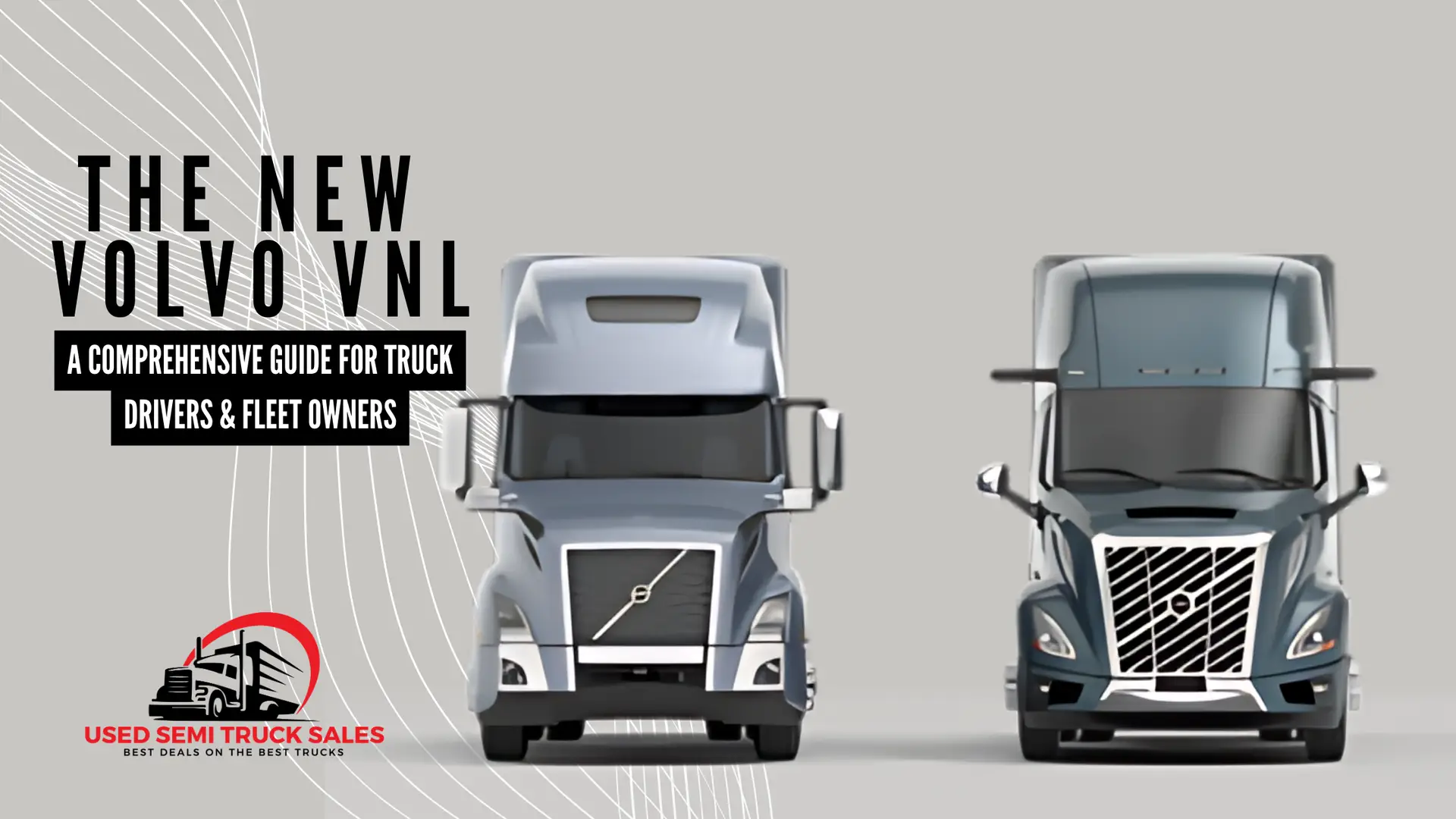
Jun
Volvo Trucks has launched a game-changing redesign of its flagship Class 8 VNL tractor. This major overhaul, the first since 2017, offers truck drivers and fleet owners significant advancements in fuel efficiency, safety, and driver comfort. But with any new model, it’s essential to weigh the benefits against potential challenges.
Forward Thinking Design and Customization
The new Volvo VNL is built with 90% new components and comes in four trim levels—Core, Edge, Edge Black, and Ultimate—and six cab configurations. This range ensures that every fleet owner can find a model that fits their operational needs and brand identity, from the VNL 300 Day Cab to the VNL 860 74-inch Full-Height Sleeper. There has been issues brought up with the loss in the size of the cab for the 860, but the increase obtained in the aerodynamics and consequential increase in fuel economy is something that I believe is a sacrifice that drivers and fleets will be willing to make.
Enhanced Fuel Efficiency and Aerodynamics
One of the standout features of the new VNL is its fuel efficiency. The truck achieves up to a 10% improvement due to aerodynamic enhancements like a wedge-shaped cab, reshaped windshield, and optimized chassis fairings. These changes not only reduce fuel consumption but also lower operational costs over time.
Advanced Powertrain and Future Technologies
The VNL is equipped with the latest D13 engine, available in various horsepower and torque ratings. The improved I-Shift transmission offers up to 30% faster shift speeds, enhancing performance. Additionally, the VNL is future-ready, with plans to incorporate battery-electric, hydrogen fuel cell, and renewable fuel engines within this design, keeping with their promise to become carbon neutral. There will be models coming out that will use cameras instead of side mirrors soon as well, leading to better visibility and aerodynamics but concerns of increased chance of malfunction with this and other technology based advancements, and therefore a potential of costly repairs and potentially hindering performance on the road.
State-of-the-Art Safety Features
Volvo has prioritized safety in the new VNL. The truck includes advanced active safety systems like Volvo Active Driver Assist Plus with lane centering and pedestrian detection. Passive safety is bolstered by high-strength steel cabs, side-curtain airbags, and a panoramic windshield for better visibility, just to name a few. Volvo Trucks have long been focused on safety and has been stated that they are building off of the huge advancements they have made on past models, so I look forward to being able to see one of these in the near future to expand on this topic more.
Driver Comfort and Technological Innovations
The VNL is designed to be a “home away from home” for drivers. Upgraded insulation, a larger refrigerator, a multifunctional control panel, and the Global Rear Air Suspension system ensure a comfortable and stable ride. The MyTruck app allows drivers to monitor vehicle conditions and control climate settings remotely, further enhancing convenience.
Environmental Impact and Sustainability
The new VNL also contributes to sustainability efforts. The integrated Volvo Parking Cooler uses the onboard 24-volt battery system for climate control when parked, reducing emissions, fuel costs, and costly equipment like an APU. This aligns with Volvo Trucks’ goal of achieving 100% zero-emission vehicle sales by 2040.
Potential Challenges
While the benefits are substantial, there are potential challenges. The advanced technology and new components may require specialized maintenance, increasing costs. Driver adaptation to automated transmissions and new safety systems may necessitate additional training. Infrastructure for electric and hydrogen vehicles is still developing, which could limit the immediate benefits of these future technologies.
The redesigned Volvo VNL offers significant advantages in fuel efficiency, safety, and driver comfort, making it a smart investment for fleet owners looking to modernize their operations. However, it’s essential to consider the initial costs, maintenance needs, and infrastructure readiness. For those ready to embrace cutting-edge technology and sustainability, the new Volvo VNL is an excellent choice.
Explore the new Volvo VNL and decide if it’s the right fit for your fleet by visiting Volvo Trucks North America‘s official website.

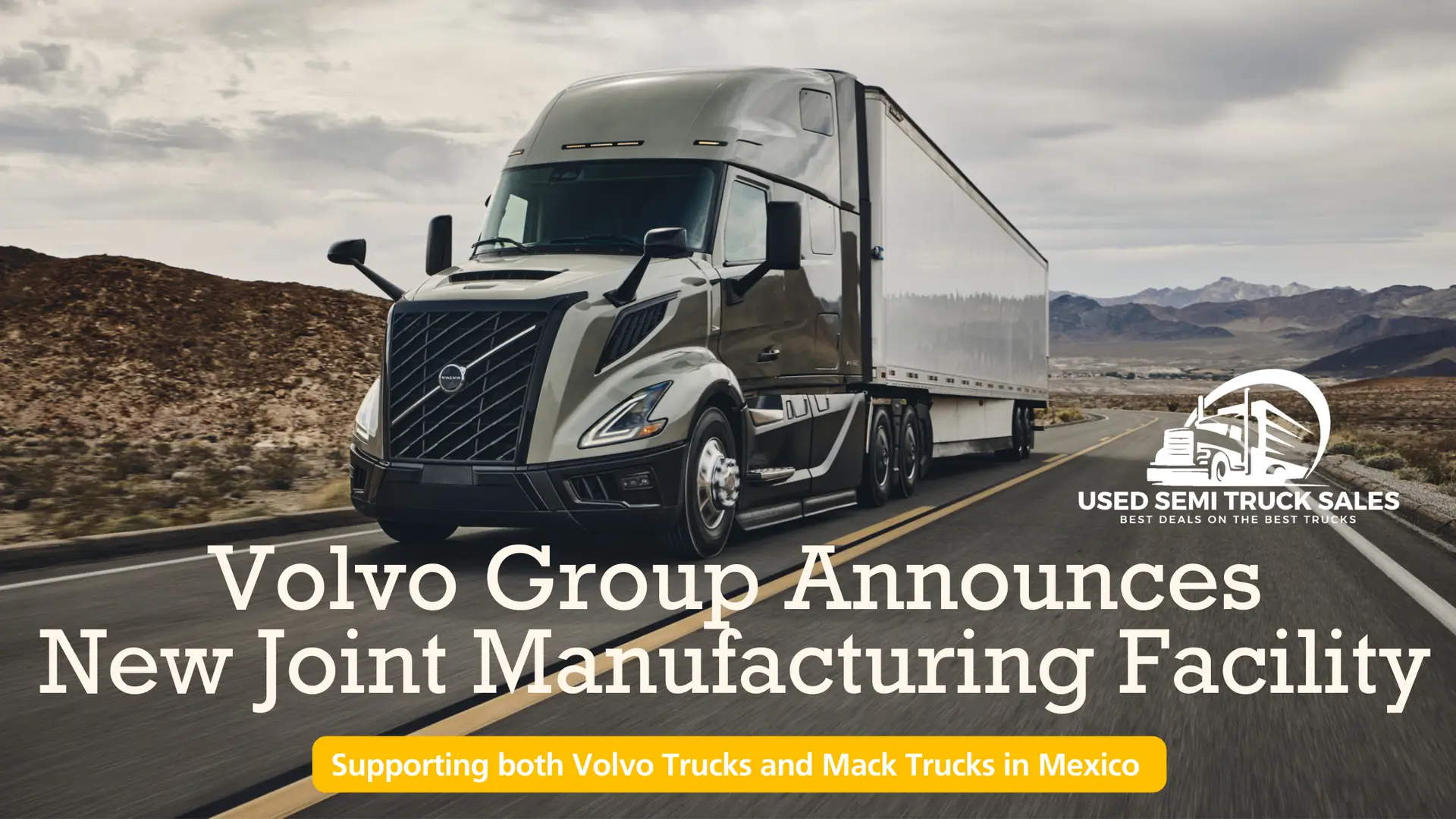
Apr
Volvo Group Expands North American Operations with New Manufacturing Facility in Mexico
Volvo Group, the parent company of both Volvo Trucks and Mack Trucks, announced on Thursday its strategic decision to enhance its North American manufacturing footprint by building a new heavy-duty truck manufacturing plant in Mexico. Scheduled to be operational by 2026, this initiative is poised to significantly bolster Volvo’s production capabilities while supplementing its existing major production sites in the U.S.
Sustained Focus on Existing Facilities
Despite the addition of the new plant, Volvo Group has reiterated that the Mack LVO plant in Pennsylvania and the Volvo NRV plant in Virginia will continue to serve as the primary production hubs for its North American operations. These facilities have seen substantial investments in recent years, with more than $73 million allocated for expansions and upgrades at the LVO plant, and an additional $80 million currently being invested to prepare for future production. Moreover, the NRV plant is completing a six-year, $400 million expansion and upgrade, focused primarily on the production of the new Volvo VNL model.
Strategic Expansion in Mexico
The upcoming facility in Mexico will extend across approximately 1.7 million square feet and will be dedicated to the production of heavy-duty conventional vehicles under both the Volvo and Mack brands. This move is expected to deliver considerable logistical efficiencies, especially in supporting sales in the southwestern and western U.S., Mexico, and Latin America.
Benefits for Volvo’s Corporate Clients
For businesses that rely on Volvo trucks, the establishment of the new manufacturing plant represents several potential advantages:
- Quicker Delivery Times: The proximity of the new facility to key markets will likely reduce delivery times and decrease shipping costs. Currently, all production is done on the east coast of the United States.
- Improved Truck Availability: With expanded production capabilities, Volvo can ensure a steadier supply of trucks, thereby helping companies fulfill their operational needs more efficiently. With the past supply problems in both companies, this will be a welcome safeguard to ensuring onetime delivery of trucks to the companies ordering from them.
- Cost Advantages: Enhanced production and supply chain efficiencies could lead to cost savings, which might be passed on to customers in various forms. While truck retail prices historically don’t go down, there are other forms that could be past on to the customers. Typically with more technological advancements available, more efficient products, and potentially lead to the point where there are excess at the dealerships, which will make Volvo Group start offering more incentives and better pricing when at the negotiating table.
- Better Service and Support: The expansion aims to improve the overall network of service and support for Volvo and Mack trucks throughout North America, enhancing customer experiences.
A Forward-Looking Investment
This expansion reflects Volvo Group’s commitment to strategically positioning itself to better meet the demands of the North American market. By increasing its manufacturing capabilities, Volvo not only reinforces its dedication to existing facilities but also enhances its competitive edge in the global commercial vehicle industry. As Volvo Group gears up for a future of increased production and efficiency, its corporate clients can anticipate reaping the benefits of a robust and responsive supply chain.

Apr
Recent Stock Market Trends in the Transportation Sector
This past Wednesday marked a significant downturn for the transportation industry in the stock market, with J.B. Hunt Transportation Services (JBHT) leading the downward movement. The company experienced a notable 7% drop in its stock price from the previous week, contributing to an average industry decline of 4% on that day alone. This downturn positioned the transportation sector as one of the poorest performers in the market that week.
J.B. Hunt’s CEO, John Roberts, commented during the company’s earnings call, stating, “The current environment we are in has remained persistently challenging and for longer than we had predicted.” This acknowledgment reflects the broader difficulties faced by the sector, highlighted by J.B. Hunt’s continuous struggle with declining earnings for six consecutive quarters and a downturn in sales for five quarters. Factors contributing to these challenges include decreasing freight rates, rising equipment costs, reduced cargo volumes, and internal company issues.
Moreover, J.B. Hunt is not alone in its financial troubles. Other key players in the industry such as Knight-Swift, Forward Air Corp., Saia Inc., ArcBest Corp., XPO Inc., Marten Transport Ltd., Heartland Express Inc., and Landstar System Inc. also reported declines in their stock values, underscoring widespread concerns across the transportation sector.
Implications for the Used Semi Truck Market
Although the direct impact of these stock market declines on the used semi truck market might be minimal, they suggest broader implications for transportation market rates. Initially expected to rise at the start of the year, these rates now appear poised to remain lower. Traditionally, lower transportation rates directly influence the pricing of used semi trucks—when rates are low, the used semi truck market tend to follow suit.
Additionally, as larger transportation companies face reduced sales, they often increase the supply of used trucks on the market by offloading older models. This influx of available vehicles can further drive down prices, creating a buyer’s market for used semi trucks.
Opportunities Arising from Market Conditions
For owner-operators and smaller fleet owners, the current market conditions present several potential advantages:
- Increased Availability of Trucks: The increase in the number of used trucks on the market means more options are available, potentially including models that are rarely sold in a more stable economic climate.
- Reduced Costs for Fleet Upgrades: With more trucks available and at lower prices, upgrading or expanding a fleet becomes more affordable.
- Expanded Hiring Options: The industry’s downturn might lead to more drivers seeking employment, providing fleet owners with a larger pool of candidates.
Challenges Ahead
Despite these opportunities, there are significant challenges to navigate:
- Persistent Low Rates: Continued low transportation rates may strain the profitability and operational capacity of small fleets and owner-operators.
- Increased Competition: An oversupply of trucks and drivers can lead to heightened competition for available hauls.
- Rising Operating Costs: A slowing economy often brings escalating costs, compounding the financial pressure on those in the transportation industry.
Understanding these dynamics is crucial for stakeholders in the transportation sector and those connected to the used semi truck market. By anticipating both the opportunities and challenges ahead, businesses can better strategize and adapt to an evolving economic landscape.
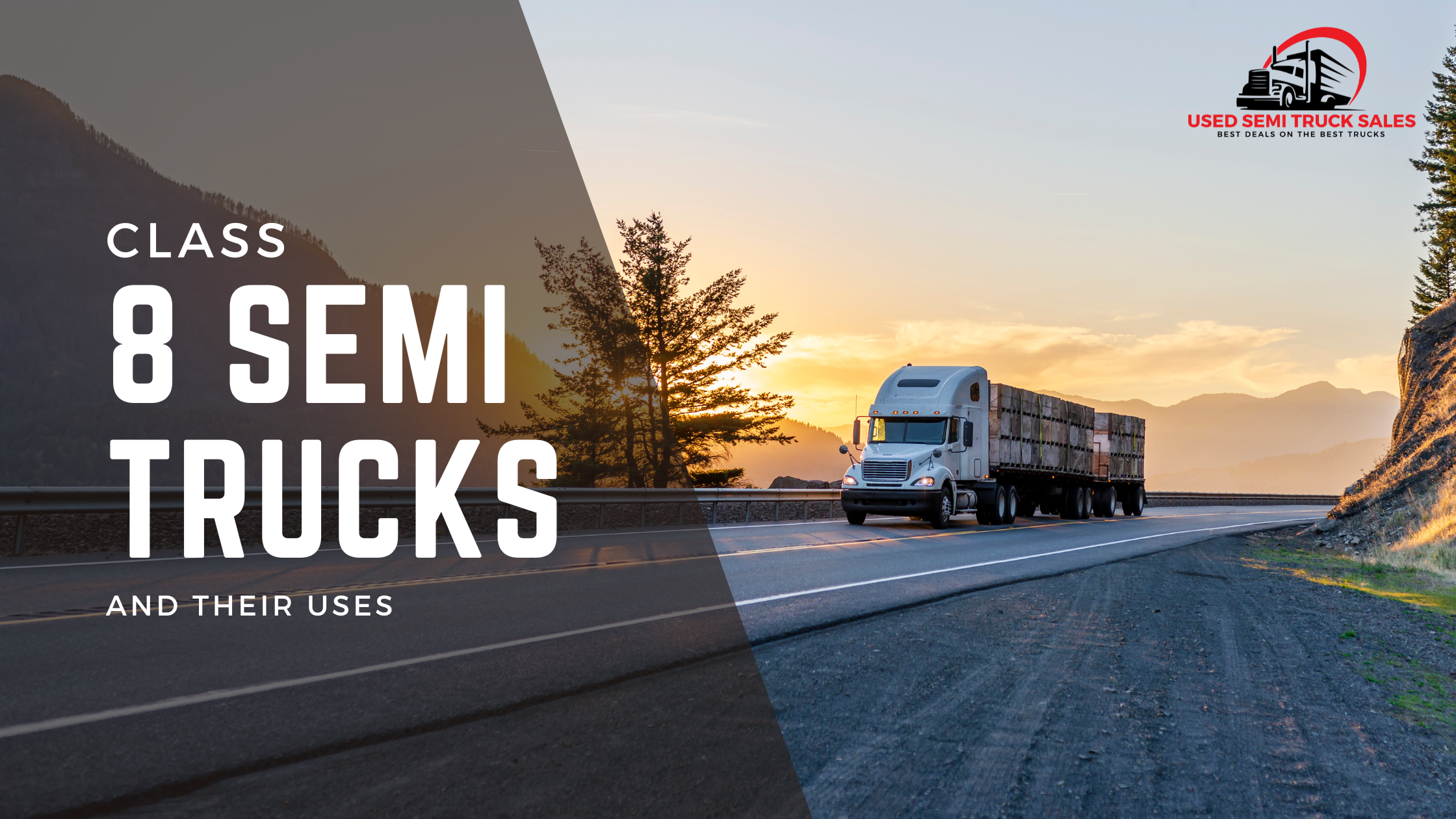
Feb
The world of Class 8 semi trucks is vast and varied, catering to a wide range of freight and hauling needs. These heavy-duty vehicles are essential to the logistics and transportation industry, moving goods across towns, cities, and countries. Each type of semi truck is designed with specific purposes in mind, from hauling bulk materials to transporting vehicles. Here’s an overview of the different types of Class 8 semi trucks and what they are used for.
1. Dump Trucks

Dump trucks are easily recognizable by their large dump body that tilts to unload material. These trucks are primarily used in construction, mining, and landscaping for transporting materials such as sand, gravel, or demolition waste. Their robust design allows them to carry heavy loads and operate in off-road conditions or construction sites. The bodies of these trucks (the portion of the truck that has the dumping capabilities) can vary. The steel body trucks are made for harder material while the aluminum body trucks are more for softer material. Each state has standards for dump trucks that local companies must comply with. For instance, Tennessee required dump trucks to have three axles, while in North Carolina, the standard is four. The different axles can change the amount of material that the trucks can transport vastly and with the required amount of axles changing geographically, it is one of the few trucks that depend on local governance to determine if it can even operate in the area. When looking into trucks in your area, knowing the standards for your area is extremely important.
2. Day Cab Trucks

Day cab trucks feature a single compartment without a sleeping area, making them ideal for short hauls that can be completed within a single day. These trucks are favored for local deliveries and regional hauling where the driver returns home at the end of the workday. They are versatile and can be fitted with various trailers to transport different types of goods. They typically have less horse power than sleeper trucks, have more simplistic design, and have small fuel capacities. With these shorter hauls, it is typical to see the used truck market have trucks with low mileage compared to their sleeper truck cousins.
3. Mid Roof Sleeper Trucks

Mid roof sleeper trucks are sometimes considered the in-between model between day cabs and raised roof sleeper semi trucks, but they are much more than that. They do have typically very roomy sleeping quarters, making them suitable for longer hauls and overnight stays. These trucks are affordable options for owner operators when compared to the raised roof sleepers, because they typically have one bed, a lot of the same comfort and performance features of the raised roof sleepers, such as horse power and engine size or options like factory install refrigerators and such. They are also very useful if the truck is hauling flat bed trailers, as there lower roof has lower levels of wind resistance. The lack in sleeper cab size, these trucks typically go for thousands less than raised roofs, so if you are looking for something to go over the road in, and you are just a single driver, these could be a great option for you.
4. Raised Roof Sleeper Trucks

Raised roof sleeper trucks are designed for the long-haul driver, featuring a high roof over the sleeper compartment for added comfort and space. These trucks often include amenities like beds, refrigerators, and storage cabinets, making life on the road easier for drivers who spend weeks at a time away from home. Having a lot of the comforts of home, these trucks are perfect for cross-country driving. A lot of the times, these truck has two bunks in the sleeping area, allowing for teams to operate the truck, tons of storage space for them to pack supplies for the weeks that they will be on the road, and the versatility to take on just about any type of load that would need to be handled. These are the most common trucks that you will see on the highways.
5. Car Haulers
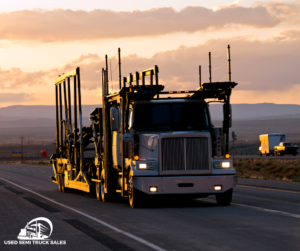
Car haulers, or auto transport trucks, are specialized trailers designed to transport vehicles. These class 8 semi trucks can be open or enclosed and are used by automotive manufacturers, dealerships, and auction companies to move cars, trucks, and motorcycles. While the open truck and trailer combo is the most commonly used, there are also enclosed car haulers that offer protection from the elements and are often used for high-value or classic vehicles. These trucks tend to need a higher horsepower to move the cargo and are almost always a truck and trailer combo. These trucks are also typically mid roof sleepers, which allow the driver to have the comfort and convenience to sleep in the rig, but also allow for a vehicle to be hauled above the cab of the truck.
6. Tanker Trucks
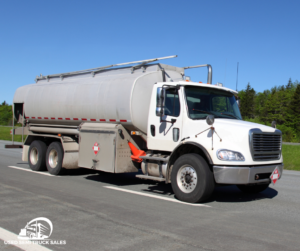
Tanker trucks are designed to transport liquids, gases, or dry bulk cargo. They are equipped with a large tank and are used for carrying different types of fuel, chemicals, water, or agricultural products. These trucks are built to comply with strict safety standards due to the hazardous nature of some of their cargoes. There are two main types of tanker trucks: a straight truck with the tank attached directly to the truck and the truck and tanker combination, where the tanker aspect is a separate trailer being hauled.
7. Refrigerated Trucks
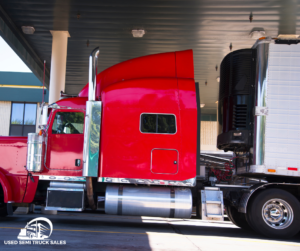
Refrigerated trucks, or reefers, are equipped with a refrigeration unit to maintain a specific temperature inside the trailer. They are essential for transporting perishable goods such as food, flowers, and pharmaceuticals. As you can imagine, these trucks and the transportation that they provide is crucial to businesses, and serve niche markets compared to the dry van loads. These trucks can be in really two different forms. The first being a box truck with a refrigerated box. The second form is in a truck and trailer configuration. The refrigeration aspect of the truck is on the trailer. Typically, the refrigeration aspect is powered by an APU, meaning that it is separate from the power of the truck and continuously keep the temperature in the container at the desired rate. if you see a device bulging out from the box or trailer at the front of the enclosure, this is typically that unit.
8. Flatbed Trucks
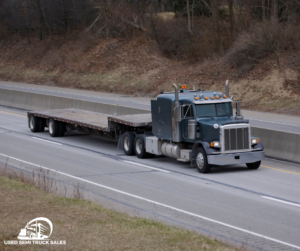
Flatbed trucks have an open trailer or attached bed with no sides or roof, making them suitable for transporting oversized loads or equipment that cannot be easily loaded into a closed trailer. The truck and tailer combination are commonly used in construction and agriculture to transport machinery, building materials, and large containers, while the straight bed trucks are used primarily for auto towing and heavy load shipping. These versital trucks have plenty of uses and different challenges that other trucks do not have. The cargo on these trucks is typically strapped in and there is not the walls or enclosures to contain the products. This is why you can see a lot of flatbed haulers with specific equipment, like ‘headache racks’.
9. Service and Tow Trucks
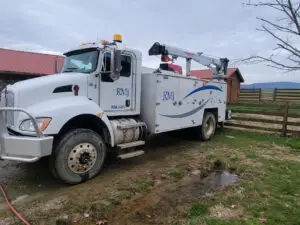
When Class 8 semi trucks break down, they need comparable trucks to come and help them off the roadways or to get them off the road. These trucks are the answer to that problem. These specialized trucks could be separated into many different categories, because each one is customized and designed for specific purposes. A commercial grade tow truck looks a lot different than a mobile truck servicing truck. They can be fitted with tool boxes, cranes, generators, and so much more. These truck are typically much higher in price because of the customization that is required to have them fill their role.
Each type of Class 8 semi truck serves a unique role in the transportation and logistics industry. From delivering perishables in a refrigerated truck to hauling heavy machinery on a flatbed, these vehicles are indispensable in keeping goods moving efficiently across the globe. Understanding the specific functions and capabilities of each truck type can help businesses and logistics professionals make informed decisions about their transportation needs.
